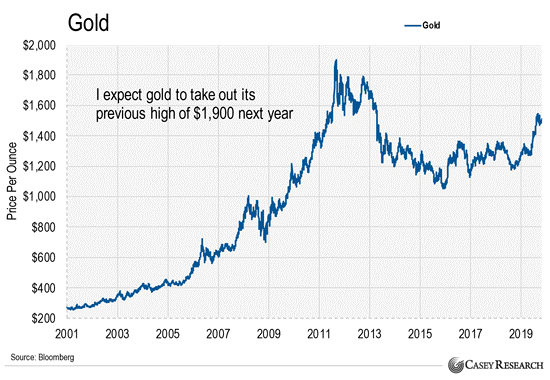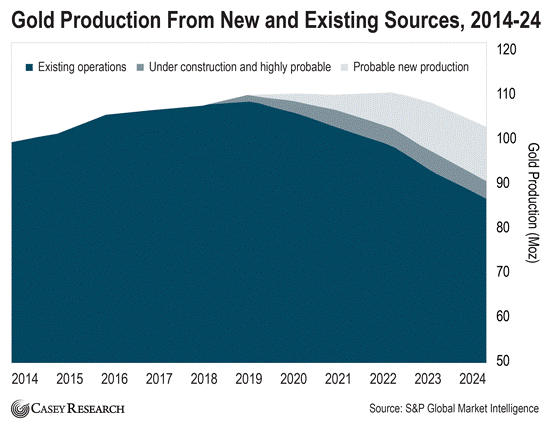Mike’s note: Mike Merson here, Jeff’s longtime managing editor.
Gold is one of the biggest investing stories of the year. From a low of just over $1,200 a year ago, gold has risen as high as 29% to $1,550 per ounce. That’s all while the broad stock market is making new highs – not the typical time for gold to rise.
Jeff’s a long-term, mega gold bull. He’s always looking for buying opportunities in the sector – and trading opportunities. Judging by our mailbags, so are you.
So when the below essay from Casey Research’s top gold expert E.B. Tucker came across my desk, detailing a truly unique way to invest in gold, I knew I had to pass it along…
I (E.B.) am very confident about gold right now.
After spending six years in a crippling bear market, gold came to life over the summer.
With little press attention, gold quickly shot from $1,270 in early May to nearly $1,550 in early September.

I’ve gone on record predicting gold will surpass its 2011 high of around $1,900. That’s about a 30% gain from here. And I expect that to happen in 2020.
A new bull market is underway… and I don’t see it slowing down anytime soon.
If I’m right, gold mining stocks – which provide leverage to a rising gold price – will surge.
But they’re not the only way to profit as this rally gains momentum.
Today, I’ll show you another way to participate in the coming gold boom.
The Big Opportunity in Gold
As we say all the time in Strategic Trader, gold mining is the world’s worst business. It’s capital-intensive. It’s labor-intensive. If a gold mine turns up in a difficult country, its leaders endlessly extort the operators.
So if it’s such a bad business, why would you invest in it?
As we always tell our subscribers, the best feature of gold miners is how they perform when gold surges higher in price.
For example, take gold’s current price of about $1,460 per ounce. Many mining companies do not make money or barely break even at today’s price. However, if the price moves $100 higher to $1,560, they’ll be in the black. That means a small move higher in gold has the potential to turn a mining firm from a money-loser into a money-maker almost overnight.
Few industries offer that kind of operating leverage. Gold miners are ultra-sensitive to movements in the price of gold. When it moves higher, they surge.
By and large, the gold mining industry hasn’t seen profits for years. That doesn’t get into the industry’s terrible track record of what to do with the profits in those infrequent cases.
After years of this, investors had enough with the industry. The 2013-2019 downturn in gold prices shown in the chart above was the final straw. Companies had little ability to raise money to run the business, much less look for new sources of gold.
That’s a key part of the mining industry. Every ounce mined is one fewer sitting in inventory. Imagine a shoe store that stopped ordering from its suppliers because its owner ran
out of money. He sold existing inventory to pay bills. After a while, shelves get thin. If shoe demand unexpectedly surges, he won’t be ready for it.
Each year, the gold mining industry pulls close to 110 million ounces from the ground. It takes about 10 years to develop a gold mine. The industry, starved for investment capital, has neglected the business of replacing the ounces it pulls from mines each year.
Pierre Lassonde, co-founder of Franco-Nevada (FNV), recently pointed this out. He said that for the ’70s, ’80s, and ’90s, in each decade, the industry found one 50-million-ounce gold deposit, several 30-million-ounce deposits, and numerous 5- to 10-million-ounce deposits.
He went on to say, “But if you look back at the last 15 years, we found no 50-million-ounce deposits, no 30-million-ounce deposits, and only very few 15-million-ounce deposits.”
As the chart below shows, mines currently in production are running out of ore. By 2024, just five years from now, the 100-plus million ounces produced from existing mines today will fall to fewer than 90 million.

Lassonde goes on to say the industry has not properly invested in replacement supply of mined gold.
This Little-Noticed Problem Is Our Opportunity Today
There has been little interest in gold this decade. The Federal Reserve’s radical money experiment worked. It threw billions of dollars at every sign of economic trouble. Now we have record-high stock prices, record-low bond yields, record-low unemployment, and a stagnant economy.
Investors feel content. That will change. The change will come when investors need to sell assets. The real value of those assets might be less than the numbers printed on their account balance each day.
This is not as farfetched as it sounds when you consider the failed initial public offerings (IPOs) of 2019. Uber Technologies, Peloton Interactive, and WeWork were all marquee private investments. They sucked in billions in private investment from the world’s most elite names. When bankers tried to unload these high-profile brands onto the public markets, their valuations cratered.
In the case of WeWork, the company’s value tumbled from $47 billion to less than $10 billion in under half a year.
At first blush, an office rental company might not look connected to gold. Look again. If high-profile investors have an asset that’s worth 90% less than they thought it was just six months prior, people begin wondering what everything is worth.
Gold is the only asset in the world that is not someone else’s liability. If asset prices crater in value for unexpected reasons, it boosts the value of an asset immune to that risk.
That could spark a surge in demand for gold. If it does, the gold market would jump higher quickly. There’s simply not enough supply.
Pierre Lassonde, the elder statesman of the gold business, pointed to this in the quote mentioned above. At current rates, mining firms are not replacing the ounces mined each year. This is Economics 101. When supply dwindles at the same time demand surges, you’ve got the makings of a frenzy. Where will new gold supplies come from? It takes a decade to permit and develop a mine.
I was standing next to Pierre Lassonde at an event in Denver earlier this fall. We both attended the Denver Gold show. It’s an annual gathering strictly limited to gold industry executives.
However, Pierre and I were not there to look for the next great gold mine. Instead, we both prefer to own a royalty on that next great mine.
Gold Royalties – A Fantastic Way to Play the Gold Boom
Gold royalty companies have all the upside benefit of mining stocks without many downside risks.
I know the gold royalty industry inside and out. I have deep connections in the business. As a director on the board of a successful gold royalty company, I know big things are coming for the space.
A gold royalty company doesn’t actually produce any gold. Instead, it lays claim to a small percentage – a royalty – on the gold that gold miners produce.
A gold royalty gives the holder a small percentage, usually 1-2%, of all the gold ever produced from a mine. The royalty has a few very important features.
A royalty survives even when a gold mining company fails. Say Company A owes the royalty holder 1% of all the gold produced at its mine. It goes belly-up. Company B buys the mine out of bankruptcy. In this case, Company B still owes the royalty holder 1% of everything that comes out of the ground.
A royalty covers future discoveries of gold on a property. Most mines go on producing far longer than planned. Once the operator is 2,000 meters and $1 billion into a project, it’s reluctant to leave. Usually, it spends money drilling looking for more gold at the bottom of the mine. The operator often finds it. The royalty holder gets 1% of that, too.
A royalty owner doesn’t care if a mining company endlessly issues stock diluting its shareholders. This happens all the time in the mining business. Operators never seem to make money and never run their companies properly over the long term. The royalty cannot be diluted. 1% is always 1% from now until the end of time.
If the price of gold surges, the royalty owner captures all the upside. Say the mining company produces 100,000 ounces of gold in a year. It gives the royalty company 1,000 ounces (1%) which the royalty company sells right away. If gold goes up $100 that year, the 1,000 ounces yields $100,000 more than it did last year. Meanwhile, the royalty holder’s cost didn’t change. The day it bought the royalty was the last dollar it paid the mining company, even if that was 20 years ago.
As you can see, the royalty business has many advantages when compared to actually mining gold.
You can get started today by looking into shares of Franco-Nevada (FNV). It’s the largest company in the sector and one of the safest ways to take advantage of the coming boom.
Regards,
 |
E.B. Tucker
Editor, Strategic Trader
P.S. Right now might be the best opportunity you’ll ever see in the gold sector.
That’s because I just discovered a little-known anomaly that has the potential to rack up gains as high as 52,900% starting in December. It’s even more explosive than gold miners or royalty companies.
It’s not a stock, bond, or ETF. And it has nothing to do with options, futures, or cryptos… but it can be bought easily through any broker.
You can watch me explain it all in this special online presentation. And I’ll even give you my top pick… 100% free. No strings attached. Go here to watch.
